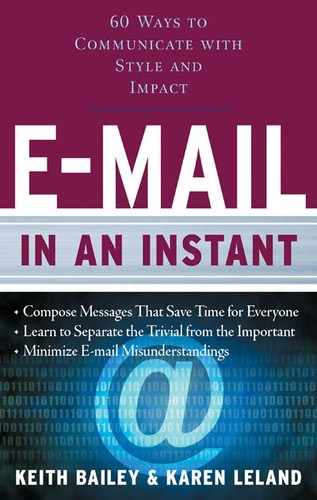33
Avoid the 10 Top E-Mail Mistakes
In the world of e-mail etiquette, almost every message contains a few mishaps and blunders. The following e-mail contains the 10 most common mistakes made. Read through the message and see if you can spot them all. We’ve listed the answers at the end, so resist the urge to cheat by peeking ahead.
Subject: Your procedure sucks!!
From: Jack B. Nimble
Date: Friday, Aug 11
To: Bill Melater
Cc: Doug Heelsin, Cal Oricounter, Carrie Mehome,
Jack Thecarup, Foster Goodtimes, Bettina Urshirtonit
I am so tirred of having to deal with your outdated and stupid prosedures >:(Everytime ZI deal with your department it turns into a LOL situation. What do I have to do to get my adress chaned? I moved 6 months ago a you still haven’t been able to update my records. I WORK IN THE SAME COMPANY AS YOU BUT YOU SEEM TO BE THE ENEMY!!!!!! My paycheck is still being forwarded from my old address this keeps me getting it late. Did you receve the form to have it deposited directly into my bank account? I don’t think so. I sent you a fax with my bank account number but you’ve probably lost that X(Here it is again: #5866634792 If you did nothing has changed!! !!!!!! I want to pick up my paycheck personally from your office—is this possible. Until this whole fiasco is cleared up. When is it cut and ready to be picked up? GET BACK TO ME SOON!!
1. _______________________________
2. _______________________________
3. _______________________________
4. _______________________________
5. _______________________________
6. _______________________________
7. _______________________________
8. _______________________________
9. _______________________________
10. _______________________________
Answers
Mistake 1: Sloppy spelling, ghastly grammar, and poor punctuation.
This e-mail is difficult to read because of all the misspelled words and badly constructed sentences. The general carelessness of the message gives the receiver an instant negative impression of the sender, and concern about his or her credibility—which all can affect future correspondence.
Mistake 2: No salutation or signoff.
Don’t start your e-mail with a description of a predicament or launch into the meat of your message. Instead, begin any e-mail (even one that is addressing a problem) with a friendly salutation. Just as important as a friendly greeting, a friendly closing is essential. Always end with a positive—thank you, sincerely, best, or another polite signoff.
Mistake 3: Divulges security-sensitive information.
E-mails are like newspapers lying around on a park bench—they can be picked up and viewed by anyone. Careful thought should be given before confidential information is written in an e-mail message. For example, the bank account number in this message might provide an unscrupulous person with information needed to wipe out the writer’s bank account.
Mistake 4: No clear request.
The writer has asked so many different questions it’s hard to know what he or she really wants the recipient to do. Does he or she want to pick up his or her paycheck, have it deposited electronically, or have it mailed to the correct address? To minimize confusion, make your requests easy to understand (and fulfill) by writing exactly what you want, and when you want it.
Mistake 5: Using all capital letters.
Capital letters are the online equivalent of shouting in someone’s face, and have been know to start many a “flame war” such that the recipient (angered by the sender’s rudeness) sends back an even nastier message … and on it goes. Only use capital letters for acronyms and proper spelling.
Mistake 6: Unclear subject line.
Most people give priority to opening e-mails with a clear and informative subject line. This message gives only a hint about what the e-mail is about, and is written rudely at that.
Mistake 7: Ambiguous acronyms.
Don’t assume your readers are up to speed on all your in-house shorthand. Play it safe by staying away from uncommon abbreviations when dealing with clients. For example: LOL (laughing out loud) might be a well-known acronym to the under-40 crowd, but not everyone knows what it stands for.
Mistake 8: Obscure emoticons.
Emoticons are symbols that add expression to an e-mail, the most common being the smiley face :-) or the sad face :-(.
In our example, the author has also used >:(, which means angry, and X(, which means pouty. It’s doubtful that many people outside of a few of the writer’s close friends will know what these mean.
Mistake 9: Lack of important information.
The writer of this e-mail would get what he or she wants much faster if he or she supplied the recipient with more important information and less attitude. For example, including specific dates when requests were made would make it easier for the reader to research and respond to the issue.
Mistake 10: Unprofessional tone.
This message, from the very first line, has a rude and unpleasant tone. Remember the old saying, “You catch more flies with honey than you do with vinegar.” If you have a sensitive problem to deal with in your e-mail, don’t make the message accusatory or hostile in nature. The reader will immediately be put on the defensive, making a helpful response unlikely.
